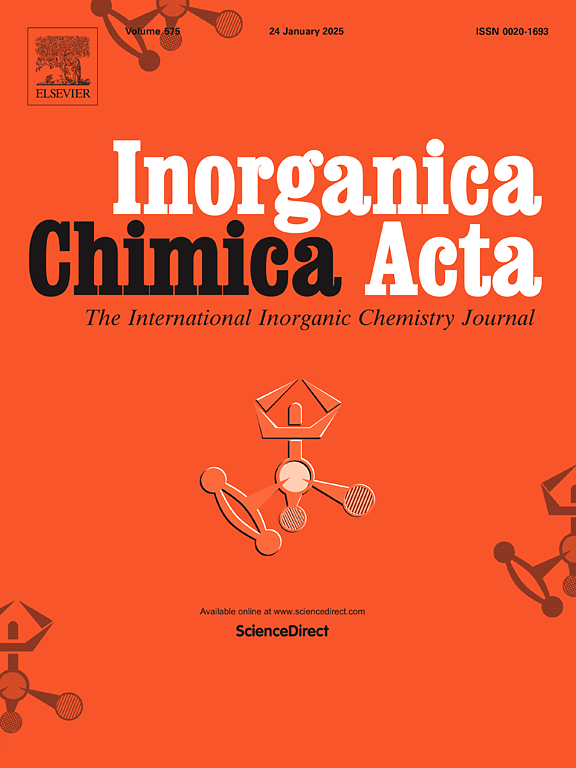A new non-centrosymmetric cuprate (II) hybrid compound [C16H36N]3(Cu2Br6)(CuBr3): Study of structural and dielectric behavior
IF 2.7
3区 化学
Q2 CHEMISTRY, INORGANIC & NUCLEAR
引用次数: 0
Abstract
A novel organic-inorganic hybrid material, [C16H36N]3(Cu2Br6)(CuBr3), was synthesized via slow evaporation and extensively characterized. Techniques such as X-ray diffraction, SEM/EDX, IR spectroscopy, and electric and dielectric studies were applied. Examination of the crystal structure reveals that the synthesized material adopts an orthorhombic system, specifically belonging to the P21212 space group, with unit cell parameters a = 25.635 Å, b = 25.996 Å, c = 20.431 Å, V = 13615.3Å3, and Z = 8. Purity confirmation was established through powder X-ray diffraction analysis. Composition verification was carried out using semiquantitative EDXS analysis. The asymmetric unit consists of three tetrabutylammonium organic cations [C16H36N]3+, two [Cu2Br6]2groups, and one [CuBr3] group, forming a 0D anionic network. C–H⋯Br hydrogen bonding combines to create a 3D hydrogen-bonded network, maintaining crystal stability. IR spectral analysis corroborated the compound's characterstics at room temperature. Impedance spectroscopy highlighted the compound's electrical properties, and the fitting of the Nyquist plot revealed that both inter- and intra-grains contribute to relaxation. The equivalent circuit is modeled by a combination of two parallel R-CPEs connected in series to explain the impedance results.

一种新的非中心对称铜酸盐(II)杂化化合物[C16H36N]3(Cu2Br6)(CuBr3):结构和介电行为研究
采用慢蒸发法制备了一种新型有机无机杂化材料[C16H36N]3(Cu2Br6)(CuBr3)。应用了x射线衍射、SEM/EDX、红外光谱、电学和介电学研究等技术。晶体结构检测表明,合成材料为正交体系,属于P21212空间群,晶胞参数a = 25.635 Å, b = 25.996 Å, c = 20.431 Å, V = 13615.3Å3, Z = 8。通过粉末x射线衍射分析确定其纯度。采用半定量EDXS分析进行成分验证。不对称单元由三个四丁基铵有机阳离子[C16H36N]3+,两个[Cu2Br6]2基团和一个[CuBr3]基团组成,形成一个0D阴离子网络。C-H⋯Br氢键结合形成3D氢键网络,保持晶体稳定性。红外光谱分析证实了该化合物在室温下的特征。阻抗谱显示了化合物的电学性质,Nyquist图的拟合显示晶粒间和晶粒内都有助于弛豫。等效电路由串联连接的两个并联r - cpe组合来建模,以解释阻抗结果。
本文章由计算机程序翻译,如有差异,请以英文原文为准。
求助全文
约1分钟内获得全文
求助全文
来源期刊

Inorganica Chimica Acta
化学-无机化学与核化学
CiteScore
6.00
自引率
3.60%
发文量
440
审稿时长
35 days
期刊介绍:
Inorganica Chimica Acta is an established international forum for all aspects of advanced Inorganic Chemistry. Original papers of high scientific level and interest are published in the form of Articles and Reviews.
Topics covered include:
• chemistry of the main group elements and the d- and f-block metals, including the synthesis, characterization and reactivity of coordination, organometallic, biomimetic, supramolecular coordination compounds, including associated computational studies;
• synthesis, physico-chemical properties, applications of molecule-based nano-scaled clusters and nanomaterials designed using the principles of coordination chemistry, as well as coordination polymers (CPs), metal-organic frameworks (MOFs), metal-organic polyhedra (MPOs);
• reaction mechanisms and physico-chemical investigations computational studies of metalloenzymes and their models;
• applications of inorganic compounds, metallodrugs and molecule-based materials.
Papers composed primarily of structural reports will typically not be considered for publication.
 求助内容:
求助内容: 应助结果提醒方式:
应助结果提醒方式:


